Coleus plants are a gardener’s dream, offering vibrant foliage in a kaleidoscope of hues. These versatile tropical plants thrive in both shade and sun, making them perfect for adding color to any garden spot. From Victorian gardens to modern landscapes, these plants have stood the test of time, continually evolving to meet gardeners’ needs. Here, we explore the wide variety of coleus available, how to care for them, and how to use them in your garden design.
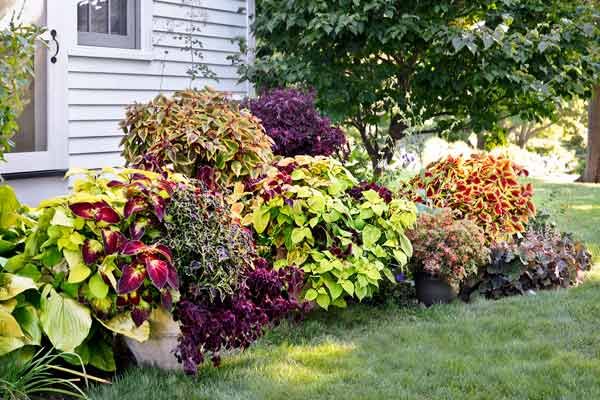
Shown: Interspersing easy-to-move potted plantings of yellow-green “Zesty Zucchini” and deep rouge “Gnash Rambler” in a border gives those varieties extra height—and allows you to change up the bed’s look as the season wears on.
The coleus plants in this article were photographed at White Flower Farm, which sells both new varieties and old favorites.
Coleus Plant Varieties
Coleus varieties come in an astounding array of colors, patterns, and leaf shapes. Whether you’re looking to brighten a shady nook or add texture to a sunny border, there’s a coleus that fits the bill. Recent breeding efforts have expanded the possibilities even further, creating sun-tolerant varieties and plants with enhanced color retention.
Sturdy, Vibrant New Breeds

Modern coleus varieties have been bred to withstand a wider range of conditions than their predecessors. These new cultivars hold their vibrant colors even in high heat and harsh light. Leaf sizes range from small and delicate to several inches wide, with edges that can be saw-toothed, lobed, or ruffled. The expansive color palette includes chartreuse, red, and smoky black—sometimes all on a single plant.
Shown: (1) “Brownie Points” and (2) “Electric Coral”
Never-Ending New Variations
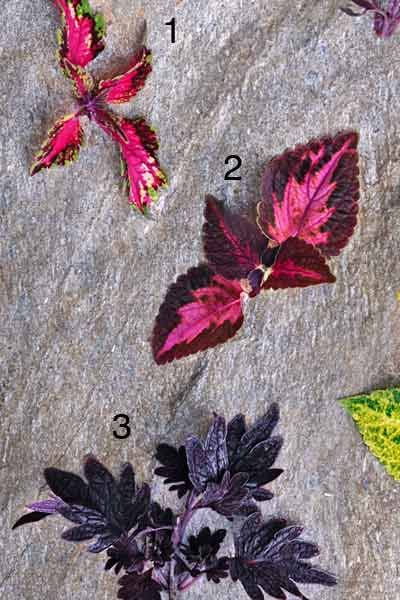
The world of coleus is constantly evolving, with new cultivars appearing regularly. Barbara Pierson, nursery manager at White Flower Farm in Litchfield, Connecticut, notes, “There are probably thousands of cultivars.” Interestingly, coleus plants sometimes develop “sports”—branches with different colors or patterns than the rest of the plant, showcasing the endless potential for new variations.
Shown: (1) “Pink Chaos,” (2) “Grape Expectations,” and (3) “Midnight Rambler”
Balancing Light and Dark Shades
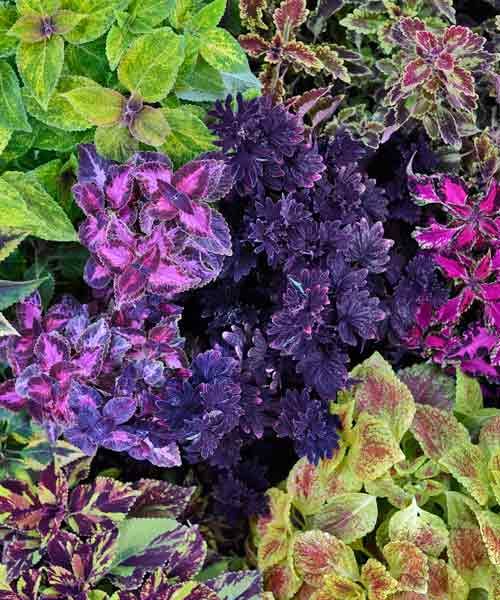
Landscape architect Joseph Marek of Santa Monica, California, was drawn to coleus as a child due to its surprising variability. He particularly appreciates varieties that combine contrasting colors, saying, “I especially love the limey-green ones etched with black, like ‘Inky Fingers,’ that brighten dark places in my garden.”
Shown: Placing the deep-hued “Midnight Rambler” front and center allows the variegated foliage around it to really shine.
Summer Planting Staples

Coleus has long been a go-to plant for summer gardens, providing consistent color while other plants cycle through their bloom periods. The newest varieties have expanded the range of colors, textures, and growing habits, making coleus even more versatile in garden design.
Many cultivar names hint at the plant’s characteristics. For example, the upright, 3-foot-tall “Big Blonde” features burgundy stems and veining on broad, yellow leaves. “Gnash Rambler” is a trailing variety with puckered, pink-and-purple foliage, while “Alligator Tears” boasts narrow leaves with yellow blazes on green. For more intricate foliage, consider the fringed, near-black “Midnight Rambler” or the exotically frilled red-and-lime “Bone Fish.”
Shown: (1) “Bone Fish,” (2) “Gnash Rambler,” and (3) “Dappled Apple”
Create Color Blocks
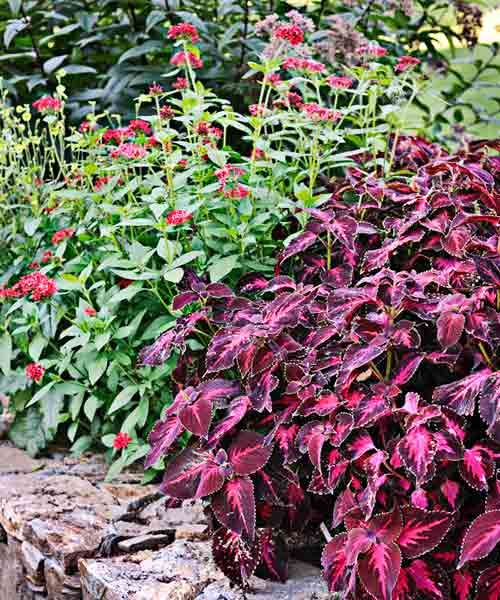
When incorporating coleus into your garden design, Marek suggests using them in large clusters for maximum impact. “Don’t just buy one or two plants,” he advises. “Use them in masses, tucked between perennials to fill space, and choose colors that complement other leaves or blooms you have.”
For seating areas, Marek recommends solid-hued varieties to create color blocks that contrast dramatically with bright seat cushions or glazed pots. In beds and containers, he suggests mixing big-leafed coleus (such as Kong hybrids) with finer-textured plants like boxwood or rosemary. Smaller-leafed coleus varieties, such as “Garnet Robe,” pair well with bolder foliage plants like Clivia or hosta.
Shown: From spring to fall, “Kingswood Torch” makes a dramatic counterpart to long-blooming “Ruby Glow” pentas.
Decorative Garden Pots
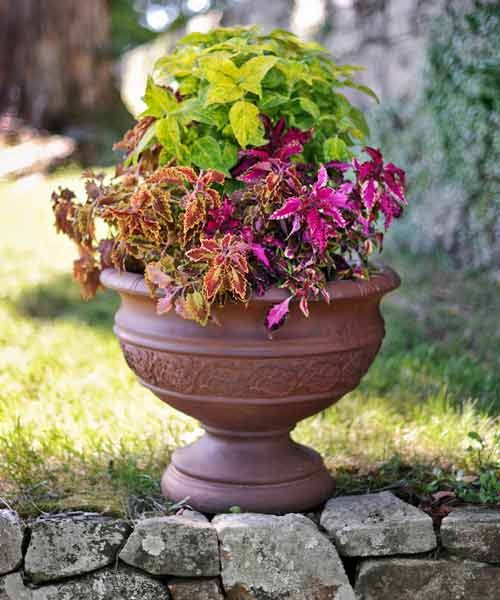
Coleus excels in container gardens, adding instant color and texture to pots and urns. Pierson recommends pairing coleus with complementary plants, such as combining the burgundy “Garnet Robe” with pastel “Spreading Salmon” impatiens and “Endless Summer” hydrangea. For a striking potted display, try layering variegated coleus varieties that echo each other’s colors, like rust-and-green “Brownie Points” transitioning between speckled yellow-green “Dappled Apple” and rosy-mint “Pink Chaos.”
Coleus Plant Care
To keep coleus thriving, plant them in partial shade and rich soil amended with organic compost and sand for drainage. “Some varieties actually brighten in sun, which can fade the older hybrids,” Pierson explains. “But part shade is perfect for every coleus I’ve ever met.” It’s important to strike the right balance—too much direct sun can fade their colors, while too little can leave them looking dull. Proper spacing, pruning, fertilizing, and watering are also key.
Spacing and Regular Care
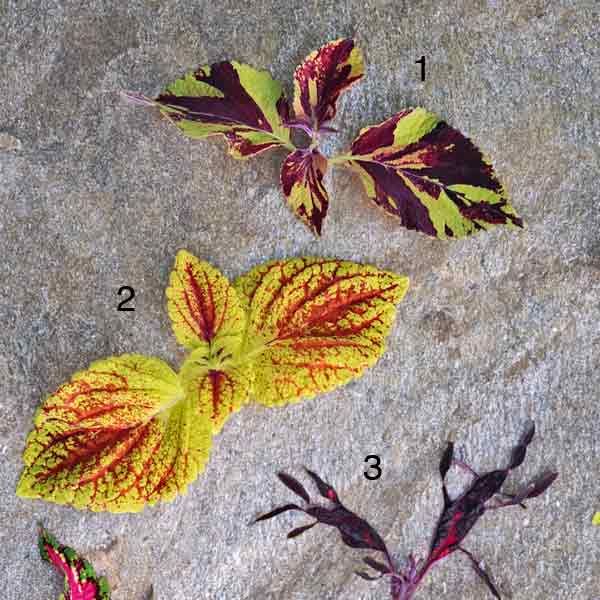
When adding coleus to your garden, consider the mature size of the plants and their light requirements. Pierson cautions, “A large coleus, like ‘Big Blonde,’ for instance, will overtake other plants fast, while small ones, like ‘Lion Fish,’ can get swamped and buried just as quickly in a pot.” She advises gardeners to give new plants elbow room and prune them freely when they sprout flower stalks or grow leggy. Pinching off flower buds encourages lush foliage growth well into fall.
Water coleus when the soil feels dry to the touch, and apply a seaweed-based fertilizer on a monthly basis. Be cautious, though. Overwatering can lead to root rot, and overfed plants may become more susceptible to pests. If you notice spider mites or other insects, try spraying the undersides of leaves with a natural horticultural oil.
Shown: (1) “Duke of Swirl,” (2) “Juicy Lucy,” and (3) “Lion Fish”
Regional and Seasonal Adjustments
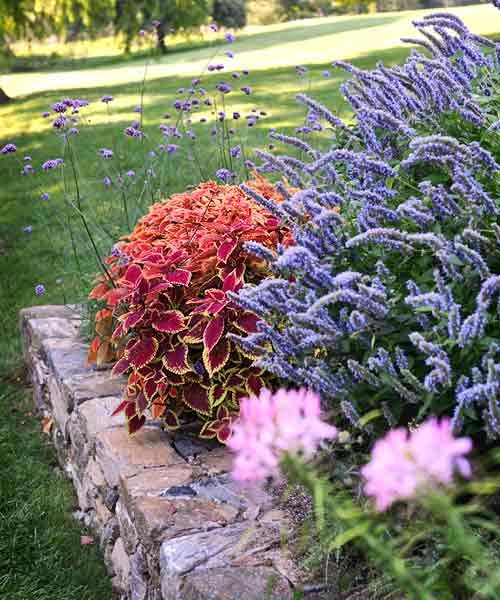
While coleus is technically a tender perennial, it’s not cold-hardy in many regions. In colder climates, gardeners often grow coleus as an annual. However, you can keep your favorite varieties going year-round by taking cuttings in early fall and propagating them indoors. When spring arrives, these cuttings will be ready to plant outdoors, ensuring your garden is dressed in colorful coleus all season long.
Additionally, it’s essential to adapt the care routines for coleus depending on seasonal variations. Use mulch to retain soil moisture during hot summers and prevent cold damage in the winter. This will help keep your coleus looking its best throughout the year.
Shown: The soft lavender hues and delicately arching habits of the surrounding flowers have a mellowing effect on mounds of “Rustic Orange” and “Trusty Rusty” coleus.
Using Coleus in Your Garden Design
For more inspiration on how to use coleus in your garden, check out the ideas and photos below.
Layering Color
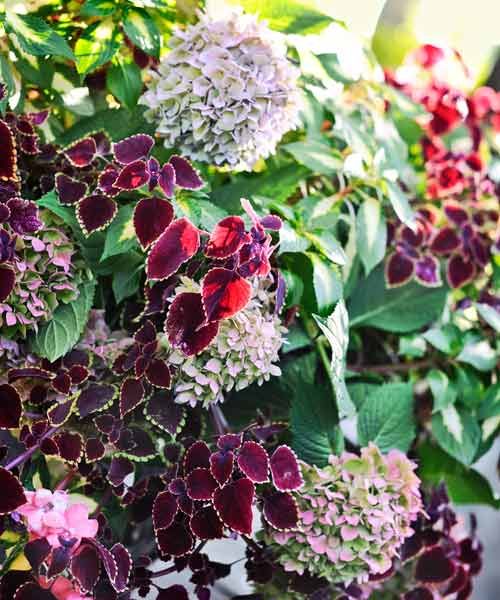
Create striking combinations by pairing coleus with plants that have contrasting shapes and colors, or layer them between plants with harmonious hues. In the picture above, green-edged “Garnet Robe” coleus beautifully complements the pink tones of a late-season “Endless Summer” hydrangea.
Evoking the Exotic
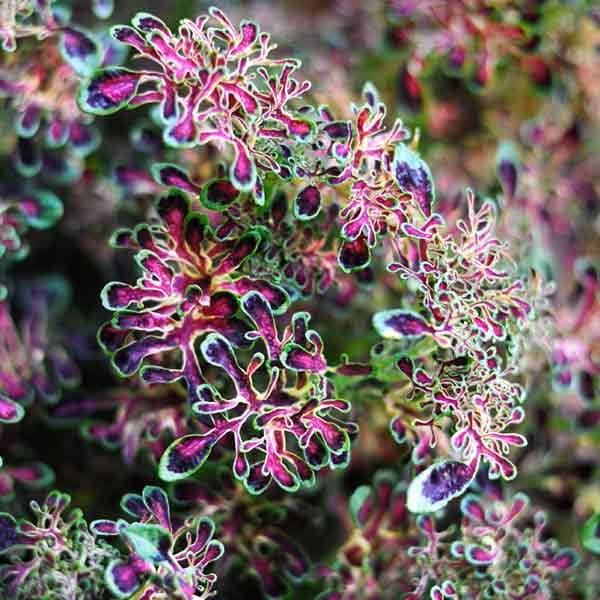
The fanciful, reef-like foliage of “Red Coral,” part of the Under the Sea series, adds a touch of the exotic to garden beds and containers. These plants stand out due to their unique texture, making them focal points wherever they’re planted.
Balancing Tones
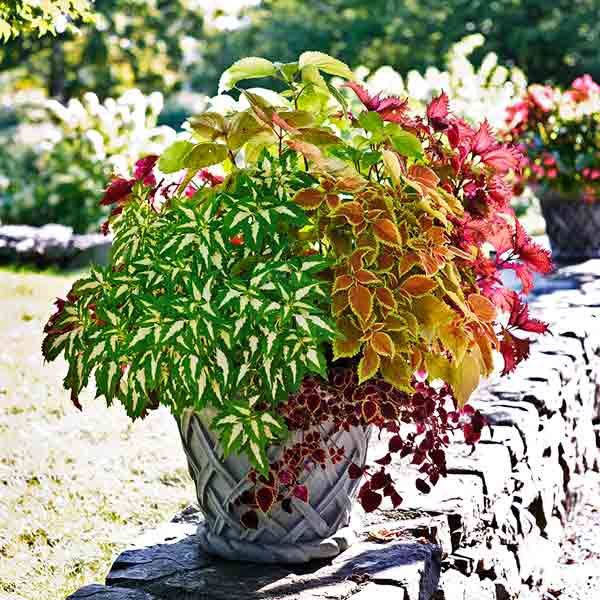
The crisp white centers and fresh green rims of “Alligator Tears” provide a cooling contrast to the warm tones of its companion plants, creating a balanced and visually appealing composition. This contrast can help maintain visual interest throughout the growing season.
Adapting to Sun and Shade
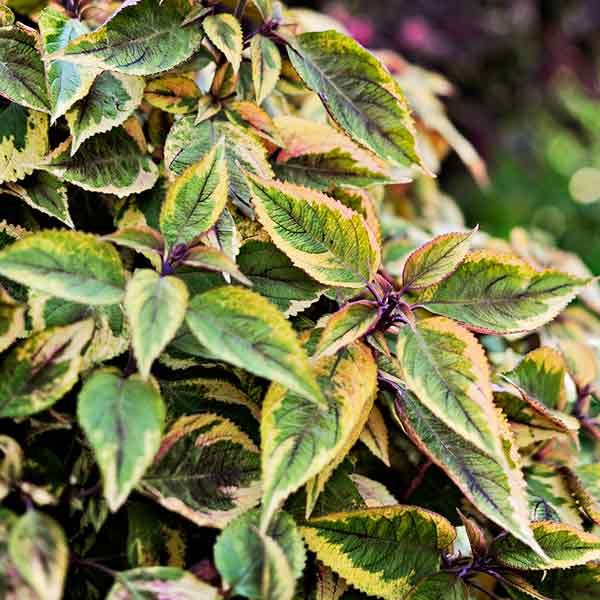
“Zesty Zucchini” exemplifies the versatility of modern coleus varieties, thriving equally well in sunny spots and shaded areas of the garden. This adaptability makes it easier to integrate these plants into diverse garden settings.
Deterring Deer
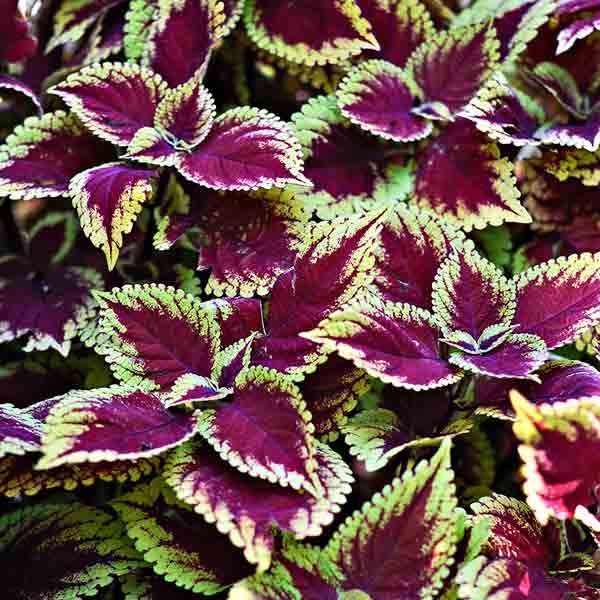
The bold coloring and scalloped edges of “Trusty Rusty” make it an attractive choice for gardeners. Fortunately, it’s not appealing to deer, which prefer other plants like hostas. This deer resistance adds to the low-maintenance appeal of coleus.
Lining Steps
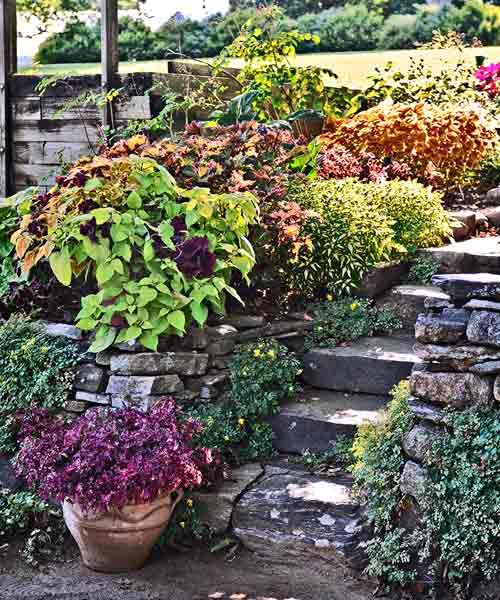
A vibrant mix of coleus, including potted “Bone Fish,” can soften the edges of lightly shaded steps, adding color and texture to hardscape elements. Such use can make pathways more inviting and create a more cohesive garden design.
Creating a Gradient Effect
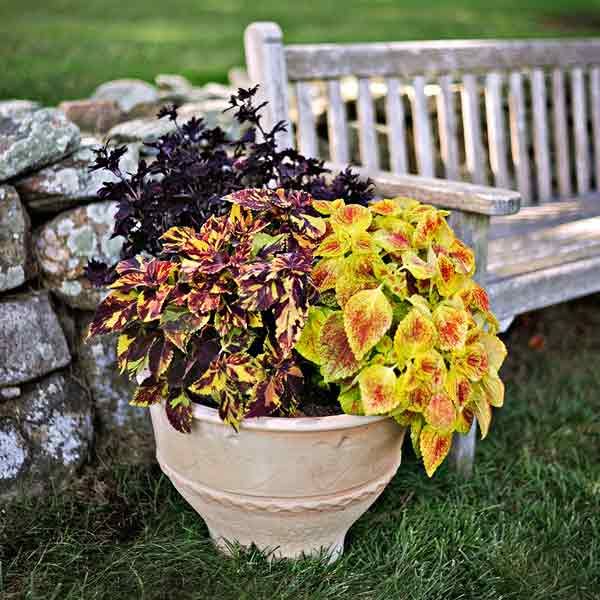
The purple-and-yellow-flecked foliage of”’Duke of Swirl” coleus acts as a perfect transition between the moody “Midnight Rambler” and the peppy “Juicy Lucy,” creating a stunning gradient effect. This use aids in creating seamless transitions in garden color schemes.
Adding Depth
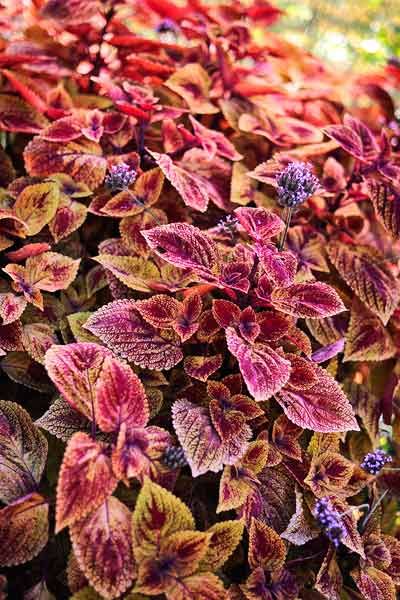
Soft, reddish-purple blooms of tall verbena peek through the foliage of “Bronze Pagoda” coleus, creating a harmonious blend of colors and textures. This intermingling of plants can add depth and complexity to a garden scene.
How To Grow Coleus Plants
Learning how to propagate coleus plants from cuttings can equip gardeners with the ability to maintain and multiply their favorite varieties—and even create new ones.
1. Cut Coleus From the Center
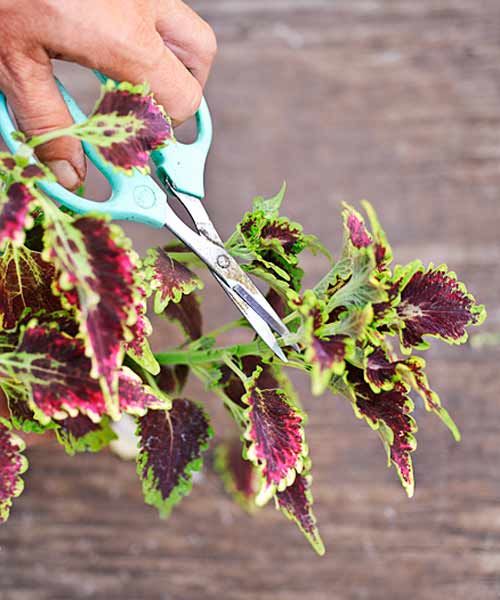
Propagating coleus from cuttings is an easy way to multiply your favorite varieties or share them with friends. Use clean, sharp scissors to cut a robust 2- to 3-inch shoot from the center of the plant, just above a leaf node. Make sure the cut is clean and angled to maximize water uptake. Remove all but one or two pairs of leaves at the top of the cutting.
2. Place Cut Stem In Water & Indirect Sunlight
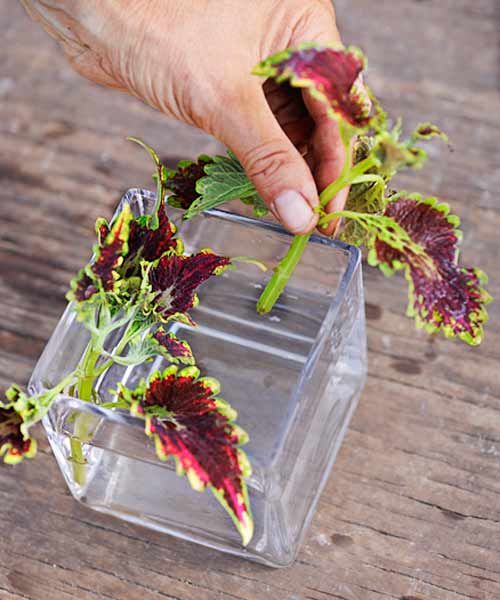
After preparing your cutting, place the cut stem in a glass container filled with room-temperature water. Make sure the leaves remain dry and exposed to air.
Position the container near a window that receives plenty of indirect sunlight and maintain a consistent temperature between 60°F and 75°F for optimal rooting. Check the water level regularly, topping it off as needed and replacing it if it becomes cloudy.
3. Wait for Roots to Grow
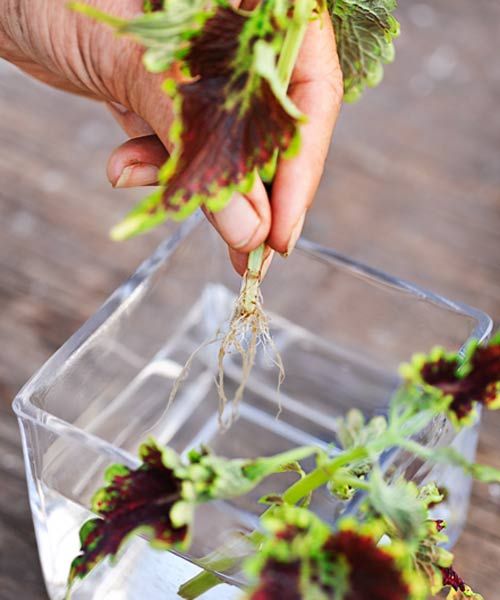
When roots have grown several inches long, gently plant the cutting in a pot filled with well-draining potting soil. It usually takes about two weeks to reach this point. Keep the newly potted coleus in a warm, bright location and gradually acclimate it to its permanent growing conditions.
Our Conclusion
Whether you’re a seasoned gardener or a beginner, coleus provides an easy way to infuse your landscape with eye-catching color throughout the growing season. With proper care and creative placement, these vibrant plants can transform shady corners, brighten sunny spots, and add depth to container gardens.
